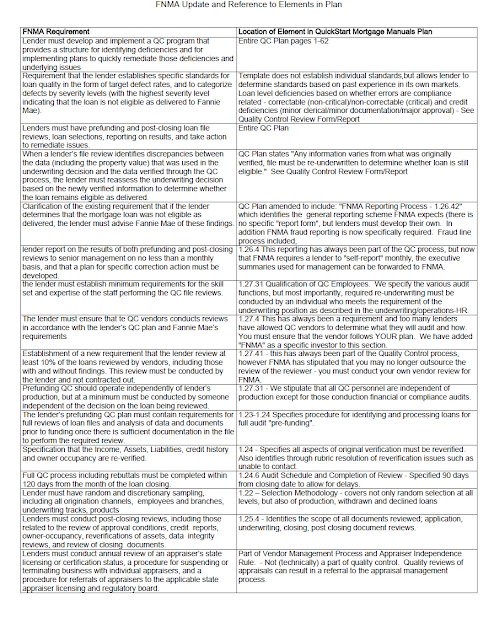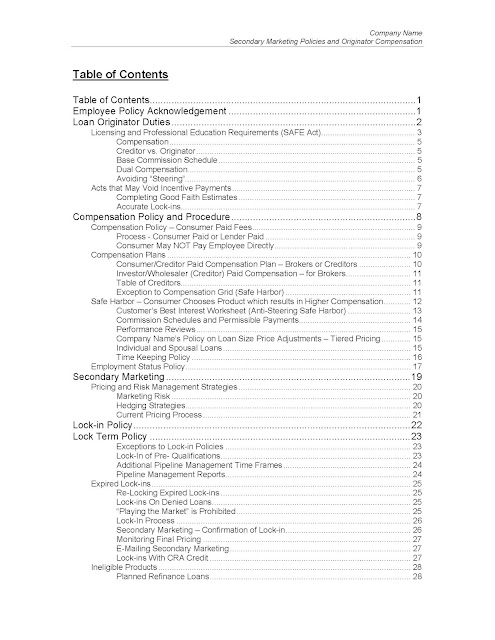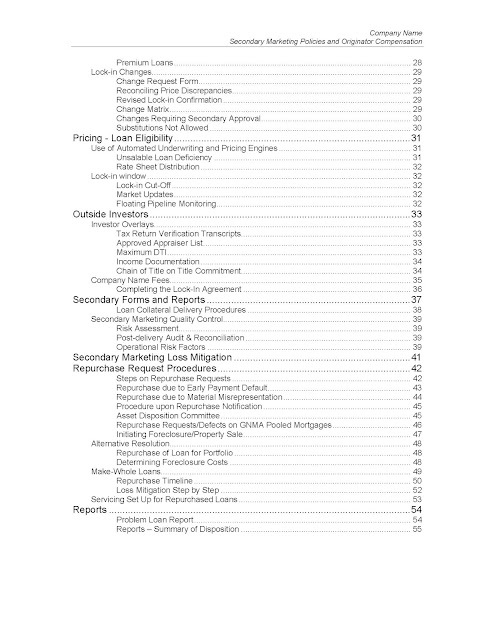There are two elements of secondary: 1.) the actual process of pricing, locking and delivering loans (and the unfortunate loss mitigation from buybacks), and 2.) hedging strategy.
You have to separate these two elements because the secondary process is pretty much standardized - we have been able to template it out.
Hedging, however, is a developing science - even an art form. So when an investor, regulator or agency asks you for a hedging policy you will be mixing a cocktail that runs from
1.) 100% hedged through forward commitments,
2.) a combination of best-efforts and mandatory whole loan delivery contracts
3.) a hedging/options adviser using options strategies - like one of the many advising firms that specialize in this.
4.) naked! (don't tell the regulator if this is how you are hedging...)
Strategies 1 and 2 are covered in the template process. If you are using an options broker to hedge pipeline, that broker will provide you with the strategy they are utlizing, and can provide the financial performance model for your lock/loan/product mix. Include your broker's hedging strategy as an addendum when providing your secondary marketing policy to a regulator, agency, warehouse bank or investor.
Having a good broker can also help you. You should get recommendations, but here is one to start with (Anthony used to be a wholesale/correspondent representative, so understands your business):
Anthony Ianni
Lender Services - MCT Trading
aianni@mctrade.net
Phone 610-742-1816 (mobile)
Additional Resources:
Article - Everything You Ever Wanted to Know About Hedging... - Schell//Hopson, 2007
Book - Demystifying Mandatory - Jennifer Fortier
Take a look at our secondary policy here:
Thursday, August 29, 2013
Thursday, August 22, 2013
Association Membership – The Ultimate Professional Network
Inexplicably, many pass on this industry benefit, which adds resources, credibility and a powerful network
It is an astonishing fact that many loan officers, processors, closers and underwriters do not belong to their local or national association. In an ad-hoc survey of state mortgage broker associations, executives reported that membership percentages hover between 18 – 26% of companies. State mortgage banker associations report somewhat higher numbers on average, but this is due to the fact that they are more selective in whom their target members are. If the mortgage bankers associations looked at all mortgage finance professionals, they would see similarly small numbers of members.
The mortgage broker conventions also tell a story of low participation. At a recent state convention, more than one attendee noted that there were more wholesale reps than members.
This can be attributed to apathy and the general lack of commitment to mortgage origination functions as a career. Compare the mortgage profession to the Real Estate industry. REALTOR – membership in the National Association of Realtors – is synonymous with the real estate agent, even though not every agent is a member of the national association of Real Estate Agents.
Political Action
Despite this apparent lack of support, we still have all benefited from the role of the associations even if we did not participate. Political action committees and lobbyists “have our backs” while we go about our business. Unfortunately, most mortgage personnel are not even aware of the issues that could affect their businesses so dramatically. Association lobbyists are in the trenches every day fighting against excessive regulation, mitigating attempts to change our business for the worse, and preventing outside players from creating more competition.
“There’s Nothing In It For Me?”
Of course, it always comes down to the benefit to the individual in participating, because there is a small cost involved in being a member. Associations do a relatively poor job of marketing the benefits of membership. Largely, they seem to believe in the principle of attraction instead of marketing. The associations don’t tout some of the benefits of membership, because there are contradictory interests between constituent groups – companies and individuals.
Education
Associations provide the most consistent source of information flow. They create ability for many different companies and individuals to attract speakers and programs that a single entity could not. As a consequence, costs for education through the association are substantially reduced from market prices.
For example, the price of live training in the marketplace is between $125 - $250 per person, per day. The average price of association provided training is $79 per person, per day. This is a substantial difference that can offset the cost of membership.
Networking
We talk about networking as if it were, in itself, a benefit. Knowing people, without an understanding of how that can help you, isn’t a benefit. The iconoclastic culture of the mortgage broker business is that we are all sort of “lone rangers” – we don’t like to ask for help and we don’t need help. Harvey MacKay, author of “Swim with the Sharks”, wrote another less well known book called “Dig Your Well BEFORE You Get Thirsty”. The wrong time to ask for a favor is when you desperately need one. Examples of relationships paying off in this way:
Help from a wholesaler to quickly get signed up for a new product
Finding out from other brokers or lenders how to deal with a specific situation
Ability to refer a troubled transaction to someone who can help
The best references on new products and investors come from these networking functions. Asking another attendee about a particular investor or transaction may yield the opinion that the investor is slow or disorganized, inflexible in underwriting, or has a penchant for declining loans when interest rates rise. This may dissuade you from using that investor, or may confirm that your experience was not an anomaly.
Some benefits of networking accrue to individuals, but not necessarily to the companies. Networking makes it much easier to find a job, hire someone, or learn of opportunities in a marketplace. No one says that these networking events are tantamount to open air employment fairs, but that is the subtext of networking.
Industry Resources
Often, membership in a state association will convey benefits from a national association. These resources include databases, research, economic analysis, business trends, and other industry information that we use to plan our business strategies.
Financial Gains
We have all seen the “affinity programs” associations tout that really aren’t anything other than envelope stuffers – discounts on car rental, overnight delivery, or phone services. However, many associations do bundle services from affiliate members – credit bureaus, bonding companies, health/disability/liability insurance and even PMI programs that can result in a financial benefit to the members.
Conventions and Meetings
Aside from being exciting and energizing events, conventions and meetings have broad opportunities in other areas. Often, higher level executives attend meetings, which help leverage a career or business venture. Combining travel to a business event with family or pleasure travel can make part of the expense deductible – if only more conventions were held in Las Vegas, Hawaii, or Orlando!
For smaller companies, association meetings or events can serve the double role of also being the member company’s “annual meeting”, chairman’s club or award event. The celebration – cost of food and drinks – can be absorbed by a benevolent sponsor’s hospitality suite, which saves the member company money. This may seem like a “cheap-o” strategy, but everyone wins. The wholesaler or vendor gets more exposure and the small member company reaps the benefits that accrue to all attendees; AND the member company gets to hold a productive meeting.
Credibility and Accountability
One of the most frequently overlooked benefits of association membership is the credibility it lends to the member. It is also the most important benefit for smaller, less established companies. Including a mortgage broker and/or mortgage banker association logo on all company materials, advertising, business cards, and correspondence infers compliance with the highest professional and ethical standards.
As a customer, seeing this credibility gives me comfort that I am not going to be taken unfair advantage of. Investors and wholesalers understand that member is striving for best practices and is willing to be held accountable, making it more likely that the investor will approve the member. Most importantly, a regulator knows that the member adheres to ethical standards and will receive the benefit of the doubt if a complaint is lodged.
Recommendations for Mortgage Associations to Add Value
I recently taught a Continuing Education class for over 150 mortgage bankers and brokers. The class comprised of mostly senior people. 80% of the attendees had over 10 years of experience; 90% had over 5 years. Compared to past years when these classes consisted of people with less than 5 years experience, the message struck me clearly: We need to bring new people into the industry.
Associations need to be at the center of community services. Volunteerism and membership accrue benefits to membership as a whole. By pooling resources members gain competitive advantage in providing services, like education, recruiting, and public relations in addition to their accepted role in political action lobbying. In addition, the association can perform a self-regulatory function, providing customers, vendors and referral sources with a mediation and arbitration source that does not involve legal and criminal sanctions.
Other Articles and Resources on Association Membership
9/2013 - Eric Kujala's Article on the Michigan Mortgage Lenders AssociationFriday, August 16, 2013
Broker v. Banker: Regulation Forces Consumers to Choose Higher Priced Loan Options
Double Counting of Fees and Misleading Disclosure Rules Lead Consumers to Choose Higher Priced Mortgage Options
Due to "double counting" of fees under the Dodd/Frank final
rule, published in the Federal Register June 12, 2013, effective January 10, 2014, consumers will be driven to choose higher priced loan options when selecting between independent originators and lenders. "Double counting" in this description, defines what occurs when compensation is included in the rate AND the concurrent originator compensation for the purposes of calculating disclosures and regulatory limits.
Higher Rates for Consumers
This example is based on 1.5% loan originator compensation. While the Dodd-Frank Rule intends to create transparency, it only impacts loans originated by a small percentage of originators, leading consumers to choose higher rate mortgages. The mathematics of this issue are discussed in detail on the IMMAAG website here.
|
Consumer confusion causes the customer to choose between the higher of two identical loans. This scenario offers a moderate comparison of the costs; at 5%, the total payments are $347,860 while at 5.125% the total payments are $352,847 - a difference of $4,967 in extra costs to the borrower.
Higher Fees for Consumers
| The mathematics of the compensation rule and the challenges posed are discussed in detail on the www.thefutureofmortgagelending.com website |
Consumers are forced to choose higher priced mortgage options under the new rules. This is required by the disclosure of originator compensation under the CFPB Final Rule, and limits of compensation under Qualified Mortgage Standards (Truth-in-Lending Act, Regulation Z), by including non-borrower paid costs in the disclosures and limits.
The Devil is in the Details
These illustrations represent the facts and not exaggerations. As clear examples of unintended consequences, one can see that the issue results from misunderstanding the technical details of the workings of the mortgage business. In attempting to regulate every aspect of the mortgage industry at a granular level, the well-meaning Congress and the Consumer Financial Protection Bureau have lost sight of their goal: "How do we help consumers?"
"If it Ain't Broke..."
The pre- Dodd-Frank Reform disclosures did this effectively for 50 years. The pre-2010 Good Faith Estimate allowed consumers to see the interest rate, the loan terms and the bottom line costs. A consumer could choose between two competing offers and decide which one suited his or her needs best.
One reform helped all industry participants. HUD's "Lock-in" of closing costs, once disclosed, ended the practice of giving one disclosure initially that bore no resemblance to the final closing costs. Congress, HUD, Sean Donovan, and the CFPB could have stopped there and declared victory.
Today's disclosures do more to conceal costs than they do to illustrate them. The 2010 Good Faith Estimate does not provide a breakdown of the total monthly payment. It includes costs that the borrower or buyer does not pay, and excludes costs and fees that borrowers do pay. The new Truth-in-Lending disclosure rules require advanced algebra to understand. I am a mortgage industry professional, an instructor and author - I have a hard time understanding the rules. How does this help consumers?
Congress has an opportunity to roll-back these provisions before they become effective. Contact your Congressman and Senator and express your disappointment at the new rules. If he or she is an advocate of transparency and fairness, they will support HR 1077 and S.949. In addition, they should advocate for the abolition of the Qualified Mortgage under Dodd-Frank, as it simply costs consumers too much money.
Thursday, August 8, 2013
FNMA QC Plan Requirement - Seller's Guide Section D Revision
FNMA has updated its Seller's Guide effective 1/1/2014 in its July 30, 2013 announcement. FNMA's quality control guidance has grown more specific since reaching the saturation tipping point on loan buybacks. Its new corporate philosophy hinges on the concept of "we told you so," instead of "buy this loan back."
The updated seller's guide's section dealing with quality control begins at page 1145 and extends to 1183 for a total of 38 pages. If you expect more than basic guidelines from this section, you should manage your expectations down. The requirements are quite general and still require the lender to make additional efforts above and beyond the stated requirements in order to ensure capturing deficiencies. Considering that our Quality Control Procedures are over 100 pages long, when all exhibits are included, industry best practices are still a better benchmark for your QC program than any single investor's idea of a plan.
Major New Requirements
While the announcement (FNMA Seller's Guide Update Announcement here) lists three pages of updates and clarifications, there are really only a few major changes, and these are not so much changes to industry best practices, but added responsibilities for sellers/originators that FNMA hopes will increase transparency in lender's processes. Effective 1/1/2014:- You must provide monthly reports to FNMA as to your quality control results, findings and remediation.
- You must report any defect resulting in an unsalable loan
- You must establish target defect rates identifying what threshold will trigger your company taking corrective action beyond the loan level remediation. This includes identifying process, personnel or product changes.
- You can no longer use another 3rd party to review your 3rd party reviewer. Vendor reviews MUST be conducted internally.
We have provided updated policies and procedures to insert into your quality control plans MortgageManuals.com's Updates and Downloads page.
A cautionary note of interest: FNMA recognizes some of the QC technology providers by name, and encourages lenders to use these technologies to AUGMENT their internal procedures. They clearly state that these measures, by themselves, do not meet requirements. FNMA wants lenders to take an active responsibility for ensuring quality, not delegate it.
It's In There
 |
| This chart links the FNMA requirements to where they should exist within an industry standard quality control plan. MortgageManuals.com customers receive these updates as part of their plans. |
Solution Template - Lenders Must STILL Determine Their Own Percentages and Procedures
We have provided a template procedure, which includes the development of reports to use in evaluating your QC reviews for patterns and identifying when targets/tolerances have been exceeded. We recommend using your LOS for capturing this data, as you can drill further down into the loan file information, and use the utilities included from most major platforms for ordering, tracking and reporting on re-verifications and conditions.
What is Your Target?
The best indication of your target defect rate is not some arbitrary computation based on industry statistics. You must examine your own experience. Break the results from your past audits down into their components. Do you have a lot of clerical errors? (4506 incorrectly completed, UDAP not submitted) What percentage of your loans get kicked back in pre-purchase reviews from your investors? Is it documentation, compliance, financial issues? Have you had any fraud, misrepresentations or substantial changes that made loans ineligible? These are the questions that should make your target defect rate obvious.Mistakes happen, but if you embrace this process your company will come to grips with the idea of process improvement and you will benefit, not only in improved loan sale activity, but in productivity as redundant mistakes get worked out of your production systems.
Subscribe to:
Posts (Atom)


